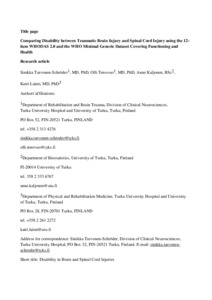Comparing disability between traumatic brain injury and spinal cord injury using the 12-item WHODAS 2.0 and the WHO minimal generic data set covering functioning and health
Sinikka Tarvonen-Schröder; Olli Tenovuo; Anne Kaljonen; Katri Laimi
https://urn.fi/URN:NBN:fi-fe2021042719667
Tiivistelmä
Objective: To compare disability between two patient groups using short validated tools based on International Classification of Functioning, Disability and Health (ICF).
Design: Cross-sectional study.
Setting: University hospital specialist outpatient clinic.
Subjects: A total of 94 patients with traumatic brain injury and 59 with spinal cord injury.
Main measures: Disability evaluated using self-reported and proxy 12-item WHODAS 2.0 (World Health Organization Disability Assessment Schedule), and physician-rated WHO minimal generic data set covering functioning and health.
Results: The two measures used showed severe but very different disabilities in these patient groups. Disability was assessed worse by physicians in the spinal cord injury population (sum 15.8 vs. 12.7, P = 0.0001), whereas disability assessed by the patients did not differ significantly between the two groups (sum 18.4 vs. 21.2). Further analysis revealed that in patients with “high disability” (the minimal generic data set score ⩾15), self-reported functioning was more severely impaired in the traumatic brain injury group compared to the spinal cord injury group (29.7 vs. 21.4, P < 0.0001), with no difference between these two diagnostic groups in patients with “low disability” (the minimal generic data set below 15). Patients with traumatic brain injury perceived more difficulties in cognition, getting along and participation, patients with spinal cord injury in mobility and self-care.
Conclusion: Both generic measures were able to detect severe disability but also to detect differences between two patient populations with different underlying diagnoses.
Kokoelmat
- Rinnakkaistallenteet [27094]
